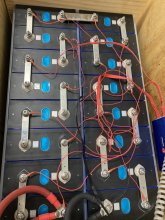I just did a capacity test on my 16s 280ah bank and cell 9 hit low well before the others (robbing me of about 28ah of capacity). I don't know if cell 9 is bad or, perhaps, it's because cell 9 is on the other side of my rectangular layout with a MUCH larger copper bus bar coming from cell 8. I'm trying to think through what would happen but it's blowing up my brain so I thought I'd ask here. I just checked the millivolt difference on the bus bars (e.g. cell 6 neg to cell 7 pos) during a 0.43C charge to get an idea of resistance and the big bar is 1.3mv and most of the others are 2.5-2.9 (I have some that are as high as 9mv ... so I'll be going and correcting any of them that are above 3mv) . Anyway ... just wondering if that's perhaps why cell 9 hit 2.5 cutoff well before the others.. was it taking more of the load due to the lower resistance? Or is that just coincidence?
In the picture, the bus bar in question is top-center.
In the picture, the bus bar in question is top-center.




